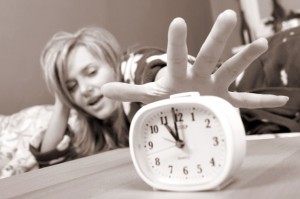Most of life is done by rote. For most of us, alarm clocks buzz the same time every morning. The average grocery store stocks over 38,000 items; yet the standard shopper goes to the same store every week, usually on the same day, and chooses from the same few dozen items every outing. We become brand loyal, eating our meals at approximately the same period every day, leave for work at a uniform time, drive a standard route, and return home at a consistent hour every night. Evenings consist of consuming one of a few “favorite” dinners. Entertainment consists of books or magazines from a few select genres and a stable of favorite authors; or maybe a regular line-up of TV shows, which we watch while sitting in “our usual place,” and snacking — or not — on the same foods we had yesterday at the same time. At day’s end, we retire at the same time, even sleeping with the same person (hopefully), only to repeat these patterns come dawn.
For most of us, alarm clocks buzz the same time every morning. The average grocery store stocks over 38,000 items; yet the standard shopper goes to the same store every week, usually on the same day, and chooses from the same few dozen items every outing. We become brand loyal, eating our meals at approximately the same period every day, leave for work at a uniform time, drive a standard route, and return home at a consistent hour every night. Evenings consist of consuming one of a few “favorite” dinners. Entertainment consists of books or magazines from a few select genres and a stable of favorite authors; or maybe a regular line-up of TV shows, which we watch while sitting in “our usual place,” and snacking — or not — on the same foods we had yesterday at the same time. At day’s end, we retire at the same time, even sleeping with the same person (hopefully), only to repeat these patterns come dawn.
This is not to suggest we are unimaginative, bland, nor boring; rather to illustrate that we are creatures of habit; no if’s, and’s, or butt’s about it.
Reality is these habits make life easier. Picture the above scenario where every single day consisted of an entirely new routine. Exciting? Sure — for a little while. After that, just plain exhausting.
The downside of a life assembled on a foundation of habits are the  “side effects;” those unexpected results of our patterns. Make no mistake however; they are every bit as much a part of the habit as are the results we seek. For example, if I’m bored, I eat. If I’m angry, I eat. If I’m sad, I eat. It’s a common routine. It allows me to feel better fast. After all, chips or ice cream not only alleviate boredom, but also go a long way toward holding negative feelings at bay — for the short term. The side effect is a weight gain. I get to feel good quickly, for the simple price of obesity long term.
“side effects;” those unexpected results of our patterns. Make no mistake however; they are every bit as much a part of the habit as are the results we seek. For example, if I’m bored, I eat. If I’m angry, I eat. If I’m sad, I eat. It’s a common routine. It allows me to feel better fast. After all, chips or ice cream not only alleviate boredom, but also go a long way toward holding negative feelings at bay — for the short term. The side effect is a weight gain. I get to feel good quickly, for the simple price of obesity long term.
Conversely, some people read a book when bored; when sad, call a friend; and when angry, take a brisk walk. (There is a clinical term for such folks: “Skinny.”) Whereby their habits also provide comfort, the side effects are healthier. Should I long for such results, I must also develop similar habits.
The thing is that it’s extremely difficult to “drop” habits. Since their sole purpose is to fill voids, simply abolishing them make those holes more painful. This in turn, triggers the very behavior we were trying to banish — which puts our actions at odds with our feelings. In a case like that, emotions almost always win out and the habit — and its side effects — strengthens.
To break this cycle, one must replace the offending behavior with a counterproductive one. So, rather than saying, “I won’t eat when stressed,” develop a plan, such as, “I’ll take a walk when stressed.” Providing you don’t also grab a candy bar on the way out the door, the anxiety is still diminished — without the pesky side effect. Yes, feels awkward at first (because it’s not yet a habit), but given a few repetitions, it eventually forms a new, healthier, habit.
We never really get rid of habits. We put them in cold storage; we can thaw them out whenever we choose. Unfortunately we do that more times than we consciously choose, which is yet one more habit we can change.
Wednesday, June 08, 2011
A primer on how to change habits
Subscribe to:
Post Comments (Atom)




No comments:
Post a Comment